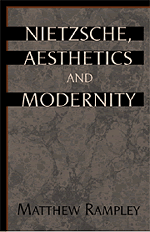Book contents
- Frontmatter
- Contents
- List of Abbreviations
- Acknowledgements
- Introduction
- 1 Truth, Interpretation and the Dialectic of Nihilism
- 2 Nietzsche's Subject: Retrieving the Repressed
- 3 Laughter and Sublimity: Reading The Birth of Tragedy
- 4 Wagner, Modernity and the Problem of Transcendence
- 5 Memory, History and Eternal Recurrence: The Aesthetics of Time
- 6 Towards a Physiological Aesthetic
- 7 Art, Truth and Woman: The Raging Discordance
- 8 Overcoming Nihilism: Art, Modernity and Beyond
- Notes
- References
- Index
8 - Overcoming Nihilism: Art, Modernity and Beyond
Published online by Cambridge University Press: 18 March 2010
- Frontmatter
- Contents
- List of Abbreviations
- Acknowledgements
- Introduction
- 1 Truth, Interpretation and the Dialectic of Nihilism
- 2 Nietzsche's Subject: Retrieving the Repressed
- 3 Laughter and Sublimity: Reading The Birth of Tragedy
- 4 Wagner, Modernity and the Problem of Transcendence
- 5 Memory, History and Eternal Recurrence: The Aesthetics of Time
- 6 Towards a Physiological Aesthetic
- 7 Art, Truth and Woman: The Raging Discordance
- 8 Overcoming Nihilism: Art, Modernity and Beyond
- Notes
- References
- Index
Summary
A central element in my account of Nietzsche's aesthetic theory has been the intimate connection between his thoughts on art in general and his concern with the crisis of nihilism. Despite his references to figures from the entire history of art, from Aeschylus, Simonides and Euripides through to Raphael, Michelangelo, Beethoven and Schubert, his concern with the question of art is primarily motivated by the pressing issue of modernity. In this respect, as I have suggested previously, Nietzsche's thought represents the latest staging of the Querelle desAnciens et des Modernes; his writing is dominated by the overwhelming sense that contemporary artistic practice is decadent, and that this decadence is all the more deplorable given that he accords to art the potential for functioning as the counter-movement to general nihilism. The most problematic case is, of course, Richard Wagner, but other figures loom prominently in Nietzsche's list of decadents, such as Zola, Delacroix, Flaubert, Berlioz and Victor Hugo. However, Nietzsche's sense of the need for aesthetic reform stems from a wider sense of cultural crisis; aesthetic renewal is necessary not only because the inherited forms of aesthetic practice bear no meaningful relation to contemporary culture, but also because modernity is to be overcome. Hence Nietzsche seems to continue the tradition stemming from Schiller, in which aesthetic reform opens the way to cultural revolution. There is an important difference, however. For Schiller, and for the early romantics such as Novalis and the Schlegel brothers, aesthetic and cultural innovation was to take place in the name of a transcendent value.
- Type
- Chapter
- Information
- Nietzsche, Aesthetics and Modernity , pp. 215 - 242Publisher: Cambridge University PressPrint publication year: 1999



